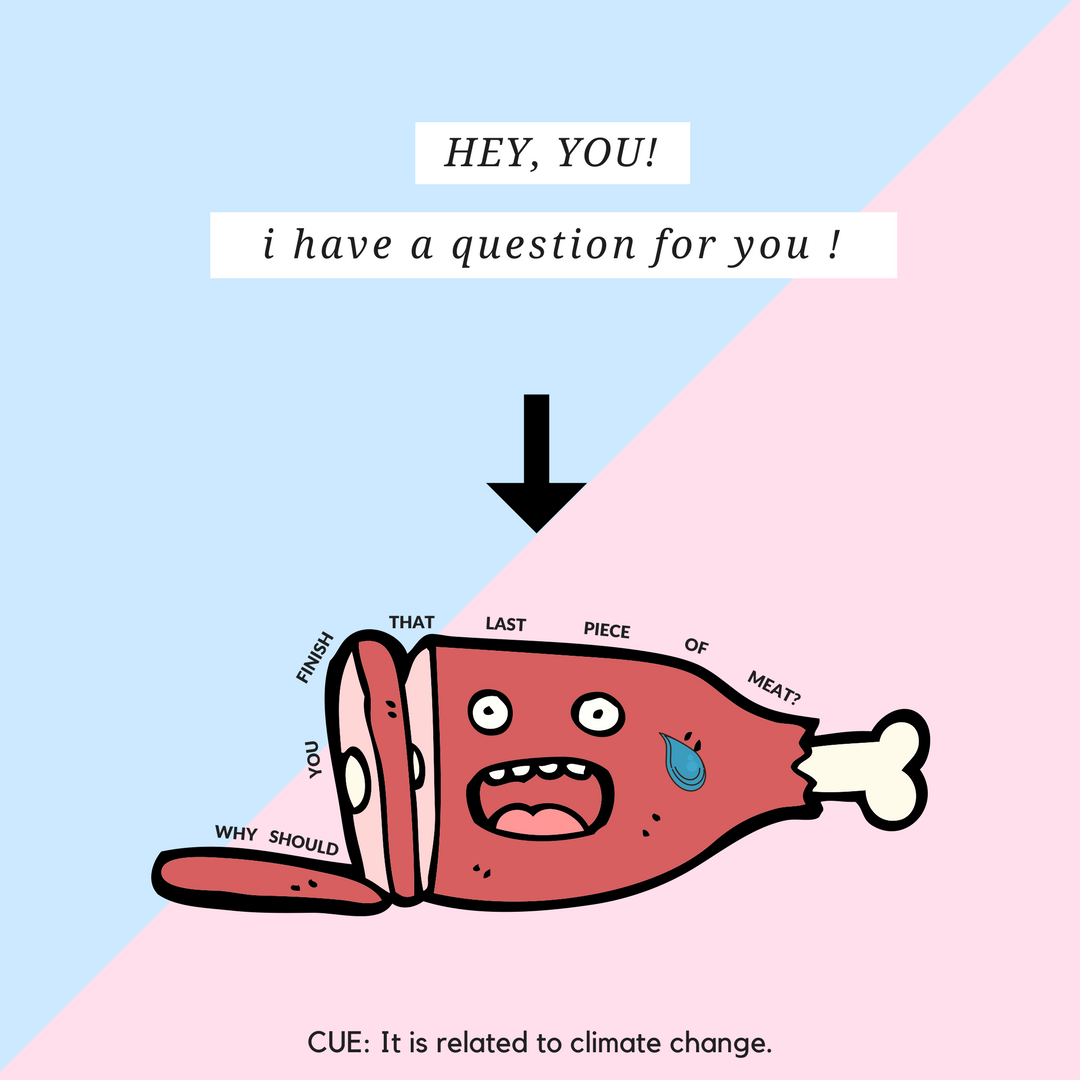Why you should finish that last piece of meat
I’m going to tell you upfront that I’m trying to get you to eat less, or even NO meat. 👀
BUT I know that’s too drastic for most of us (even for myself), so I am going to take a moderate stance - that is to ask you to treasure the meat you’ve ordered and FINISH the whole portion without wasting any bit of it, as what you’re enjoying is at the cost of climate change, environmental degradation, and of course, the blood and pain endured by animals.
**
How you should read this post
The below is not an exhaustive list of reasons why I think we should consume less meat, but I find them most compelling - climate change. I have NOT copied and pasted any of these from any websites, although my inspiration came from a documentary called Cowspiracy and started doing my research from there.
Here on, I’ve read references suggested by the documentary, through lens to verify their arguments and also research from scratch some basic facts to construct my own arguments. So you see - the evidence might be similar, but the delivery / the way we lay our arguments are different.
**
Bring it on!!!
The basics
Let’s go back to basics first - global warming aren’t always only about CO2 (carbon dioxide).
Global warming 🔥 refers to the state where the temperature of the earth increases. This is not a cause but a result. The cause is “greenhouse effect”, which means the atmosphere traps heat radiating from Earth toward space [1]. No, it’s not about how much heat is coming into the Earth (a), it is about how ‘thick’ our blanket is on Earth. Imagine you sleeping in bed with a thin blanket vs a thick blanket. You will feel warmer with a thick blanket on because it is trapping your body heat - ‘greenhouse gases’ is the blanket.
What is the blanket made of? Water vapor, carbon dioxide, methane, nitrous oxide, and chlorofluorocarbons (CFCs).
However, some greenhouse gases are capable of making the blanket ‘thicker’ than others.
Here we introduce a concept called ‘global warming potential’ (GWP) (b) - which compares the heat trapping ability of a particular gas with that of CO2. GWP is calculated for different timespans, e.g. within 20 years (GWP 20) and 100 years (GWP 100). [2] The higher the GWP, the more ‘guilty’ the gas is in contributing to global warming.
For exmaple, Methane & Nitrous oxide has a GWP20 of 72 & 289 respectively. [3] Both are ‘evil’ greenhouse gases because
Methane:
It’s GWP100 declines to 25 [3], because its lifetime (how long they stay in the atmosphere) is shorter (12 years). But this doesn’t mean they are less harmful - remember that in 20 years time they still is 72 times more capable to trap heat than CO2.
Nitrous Oxide:
It’s GWP remains high but doesn’t increase a lot (GWP100 is 298 vs GWP20 is 289) because of its long lifetime (114 years). [3]
Where do these evil gases come from?
Methane:
“during the production and transport of coal, natural gas, and oil. Methane emissions also result from livestock and other agricultural practices and by the decay of organic waste in municipal solid waste landfills” [4]
Nitrous oxide:
“Nitrous oxide is emitted during agricultural and industrial activities, as well as during combustion of fossil fuels and solid waste” [4]
How is this specifically related to animal agriculture?
If you can’t read the words ‘lifestock’ in the above paragraphs, let me try to rephrase it here.
Livestock agriculture (cattle, buffalo, sheep, goats, camels, horses, pigs and poultry), in 2006, United Nation’s Food & Agriculture Organization (FAO) discussed that it accounts for 18% of greenhouse gases emissions measured in CO2 equivalent [5], this means that despite it might be attributing to a little %s in GHGs, their impact (as their GWP is high) converted to CO2 impact, makes 18% of the greenhouse gases.
It emits 37% of human-induced methane, and 65% of human-induced nitrous oxide.
In 2009, another study from WorldWatch Institute [6] claims that livestock agriculture actually contributes 51% of annual worldwide greenhouse gases emissions. The revision in number, they claim, is because the FAO underestimated the amount as it didn’t take into consideration mainly the following:
CO2 caused by respiration (breathing) of livestock,
CO2 absorption ability forgone due to deforestation due to making land available for grazing, and
using a GWP100 of methane to convert back to CO2 (as you see above using GWP100 instead of GWP20 actually underestimated the impact of methane) - see graph below/right. (c)
If you cannot visualize why methane is produced in animal agriculture, think farts : methane is produced in the intestines of herbivorous animals (human included). Cows emit the most, followed by sheep, pigs, and humans [8]. Another study also concluded cows emit the most methane compared to deer and sheep [9].
What do we do
This is why I felt strongly about consuming less meat & dairy products - who told us that we must eat meat & drink milk in order to be healthy? I can tell you that we don’t have to - I will probably do a separate post later on what are the substitutes of meat & milk.
I cannot ask everyone to stop eating meat all of a sudden, but at least consume less meat, or at least FINISH the beef on your plate.
If you've stuck with me for this long, here's
FUN FACT TIME!!
Another interesting thing that I’ve come across online is that rice paddies actually also contributed to methane emissions! [13] ‘Puddling’ (planting in flooded rice paddies) will cause paddy soil becomes depleted of dissolved oxygen, and microbes that breakdown plant matter produce methane. Flooded soil trap large quantities of methane and then it escapes into the atmosphere. At least 90% of rice land globally is temporarily flooded, so imagine the impact when rice is a staple food for more than half the world’s population! [10]
But actually puddling is not the best way to cultivate rice - Chinese & Japanese farmers typically drain their rice paddies once during mid-growing season because they have found it increases yields [11], but this might not be applicable in other regions. In particular, since 2000, around 80% of farmers have been using the mid-season drainage, but the catch is that this practice also increased the release of nitrous oxide, but there is still a net reduction of greenhouse gases in terms of CO2. [12]
Notes:
(a)
The assumption is that climate change is not caused by changes in the sun’s radiation output. Indeed, the sun’s solar output had changed (decline) before, which had caused a Little Ice Age between 1650-1850, but since 1750, the amount of energy coming from the sun had remained constant or increased only slightly (which is not enough to explain the drastic increase in Earth temperature). [1]
(b)
The GWP depends on the following factors: the amount absorption of infrared radiation, what wavelengths is absorbed, and the length of atmospheric lifetime. A high GWP is correlated with a high infrared radiation and a long atmospheric lifetime. [2]
(c)
There are opinion that the United Nations and policy makers should STOP using GWP100 as a point of reference, as it underestimates the immediate (or shorter-term, say 20 years) impact of methane. [7] The ability to trap heat might diminishes for after 20+ years, but this should not divert attention from the fact that methane does trap heat 72 times more than CO2 for 20 years of time.
[1] - https://climate.nasa.gov/causes/
[2] - https://en.wikipedia.org/wiki/Global_warming_potential
[3] - https://www.ipcc.ch/publications_and_data/ar4/wg1/en/ch2s2-10-2.html#table-2-14
[4] - https://www.epa.gov/ghgemissions/overview-greenhouse-gases
[5] - Henning Steinfeld et al., FAO, Livestock’s Long Shadow: Environmental Issues and Options (2006), available at http://www.fao.org/docrep/010/a0701e/a0701e00.htm.
[6] - http://www.worldwatch.org/files/pdf/Livestock%20and%20Climate%20Change.pdf
[7] - https://www.scientificamerican.com/article/how-bad-of-a-greenhouse-gas-is-methane/
[8] - http://news.bbc.co.uk/1/hi/magazine/8329612.stm
[9] - http://www.sciquest.org.nz/node/42043
[10] - http://climatenewsnetwork.net/rice-puddling-raises-methane-threat/
[11] - https://www.wri.org/blog/2014/12/more-rice-less-methane
[12] - http://www.nature.com/news/2009/090818/full/news.2009.833.html
[13] - http://planetsave.com/2009/06/07/global-warming-effects-and-causes-a-top-10-list/












